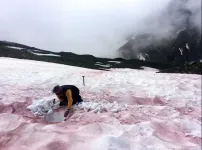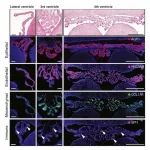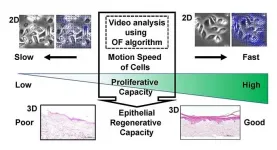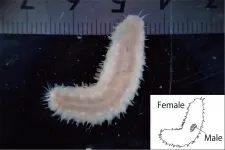ALPALGA: The search for mountain snow microalgae
2021-06-07
(Press-News.org) In a white ocean, well above sea level, the algae thrive. Normally invisible to the naked eye, they are often spotted by hikers trekking through the mountains in late spring as strikingly coloured stretches of snow, in shades of ochre, orange and red. Known as "glacier blood", this colouring is the result of the punctual multiplication (or bloom) of the microalgae that inhabit the snow.
But apart from this impressive phenomenon, the life and organisation of mountain microalgae communities remains a secret. It is this still unknown ecosystem, now threatened by global warming, that needs to be explored. The ALPALGA* consortium aims to meet this challenge by organising and pooling research efforts on snow microalgae, and it has already received support from the Agence nationale de la recherche and the Kilian Jornet Foundation.
In an initial study involving three consortium laboratories**, researchers established the first map of snow microalgae distribution along elevation. In fact, as with vegetation, the different species of algae live at varying elevations on the mountains. The genus Sanguina, for example, which gives a characteristic red colour to the snow, has only been found at altitudes of 2000 metres and above. In contrast, the green microalgae Symbiochloris only live at altitudes below 1500 metres.
These results, obtained by collecting DNA from five Alpine sites, forms the foundation on which ALPALGA will build its work. The scientists will try to answer fundamental questions such as: what species of microalgae inhabit the snow? How can these organisms withstand such extreme temperature and sunlight conditions? Does global warming favour blooms? What effect do blooms have on snowmelt? The aim is to study the process of transformation of this ecosystem in order to promote and protect it.
INFORMATION:
*- The consortium includes researchers from the Laboratoire de physiologie cellulaire et végétale (CNRS/CEA/INRAE/Université Grenoble Alpes), Laboratoire d'écologie alpine (CNRS/UGA/Université Savoie Mont Blanc), Jardin du Lautaret : découverte et sciences (CNRS/UGA), l'Institut des géosciences de l'environnement (CNRS/IRD/UGA) and the Centre d'étude de la neige du Centre national de recherches météorologiques (Météo-France/CNRS).
**- The Laboratoire de physiologie cellulaire et végétale (CNRS/CEA/INRAE/Université Grenoble Alpes), le Laboratoire d'écologie alpine (CNRS/UGA/USMB) and the Jardin du Lautaret : découverte et sciences (CNRS/UGA).
[Attachments] See images for this press release:

ELSE PRESS RELEASES FROM THIS DATE:
2021-06-07
Mental health visits for new mothers were 30% higher during the COVID-19 pandemic than before the pandemic, particularly in the first 3 months after giving birth, found new research in CMAJ (Canadian Medical Association Journal). https://www.cmaj.ca/lookup/doi/10.1503/cmaj.210151
"Increased visit rates began in March 2020, although the state of emergency was declared only midway through the month, suggesting that distress related to the pandemic translated into an increased need for care very quickly," writes Dr. Simone Vigod, chief of psychiatry, senior scientist and interim vice president of academics at Women's College Hospital (WCH), and senior adjunct scientist at ...
2021-06-07
New research indicates that patients hospitalized with active cancer were more likely to die from COVID-19 than those with a history of cancer or those without any cancer diagnosis. The findings published by END ...
2021-06-07
A traditional Vietnamese meat snack could hold the key to developing a safe and natural food preservative, addressing the twin global problems of food waste and food-borne illnesses.
Key Points
Bacteria-killing compound discovered in Nem Chua, a fermented pork snack
Toxic to bacteria but safe for humans, it's a natural alternative to artificial food preservatives
New study reveals ideal growth conditions to potentially make the bacteria-killer at industrial scales
The fermented pork snack, Nem Chua, is eaten raw but does not cause food poisoning when prepared correctly.
This is because friendly bacteria that thrive in the fermented meat make a special compound that destroys more dangerous bacteria.
Now ...
2021-06-07
Once viewed merely as a producer of the cerebrospinal fluid (CSF) bathing the brain and spinal cord, the choroid plexus is now known to be a key player in brain development and immunity. These fronds of brain tissue, located in the CSF-filled brain cavities known as ventricles, secrete instructive cues into the CSF to regulate brain development. They also function as an important barrier between the brain and the rest of the body.
Maria Lehtinen, PhD, of Boston Children's Hospital has done much of the pioneering work in understanding this once-obscure tissue. In new work published in Cell, Lehtinen, Neil Dani, PhD, and other colleagues at Boston Children's and the Broad Institute created ...
2021-06-07
The friendship paradox is the observation that the degrees of the neighbors of a node within any network will, on average, be greater than the degree of the node itself. In other words: your friends probably have more friends than you do.
While the standard framing of the friendship paradox is essentially about averages, significant variations occur too.
In the Journal of Complex Networks, Santa Fe Institute and University of Michigan researchers George Cantwell, Alec Kirkley, and Mark Newman address this by developing the mathematical theory ...
2021-06-07
Carried like stowaways in the guts of international travelers, new and potentially deadly strains of antimicrobial resistant superbugs may be coming to a community near you, suggests new research from Washington University School of Medicine in St. Louis.
"Even before the COVID-19 pandemic, we knew that international travel was contributing to the rapid global increase and spread of antimicrobial resistance," said Alaric D'Souza, an MD/PhD student at Washington University and a co-first author of the study to be published June 6 in Genome Medicine. "But what's new here is that we've found numerous completely novel genes associated with antimicrobial ...
2021-06-07
Climate experts warn that, without urgent action, climate change will continue to cause an increase in the intensity of extreme rainfall that can lead to severe flooding.
An international research team have concluded that increases in extreme rainfall and associated flooding are projected to continue as global temperatures continue to rise. Efforts to limit warming to +1.5C will help limit changes in extreme rainfall, though some societal adaptations will still be required.
Sharing their findings in a new ScienceBrief Review, published today (7 June), scientists ...
2021-06-06
Niigata, Japan - A comprehensive investigation on cells and colony motion offers new insight into the proliferative and epithelial regenerative capacities of human primary oral keratinocyte cultures with implications for quality control of engineered cells used in regenerative medicine. Dr. Kenji Izumi and his colleagues, Dr. Emi Hoshikawa and Dr. Taisuke Sato, modified the optical flow (OF) protocol originally presented in their 2019 paper to add the capacity to determine the threshold of the cells/colony motion speed required to differentiate substandard oral keratinocyte populations before manufacturing a tissue-engineered oral mucosa tissue construct. ...
2021-06-06
The world is one step closer to ultimately secure conference calls, thanks to a collaboration between Quantum Communications Hub researchers and their German colleagues, enabling a quantum-secure conversation to take place between four parties simultaneously.
The demonstration, led by Hub researchers based at Heriot-Watt University and published in Science Advances, is a timely advance, given the global reliance on remote collaborative working, including conference calls, since the start of the C19 pandemic.
There have been reports of significant escalation of cyber-attacks on popular teleconferencing platforms in the last year. This advance in quantum secured communications could lead to conference calls with inherent unhackable security measures, underpinned by the principles of ...
2021-06-05
In the Kumano Sea, off the southeast coast of Japan, an evolutionary mystery lay in wait. Researchers collected samples from the muddy sea floor, including hermit crabs, mollusks and discarded shells. Here, in and on these shells, they found scale worms living mostly in pairs with a striking difference compared to the almost 900 already known species of scale worms: one was a quarter the size of its mate.
The discovery was published on March 29 as the cover of the Journal of Zoological Systematics and Evolutionary Research.
"The species is characterized by males being dwarf, with their minute bodies always riding on the dorsal side of females," said paper author Naoto Jimi, postdoctoral researcher at the National Institute of Polar Research, Research ...
LAST 30 PRESS RELEASES:
[Press-News.org] ALPALGA: The search for mountain snow microalgae




